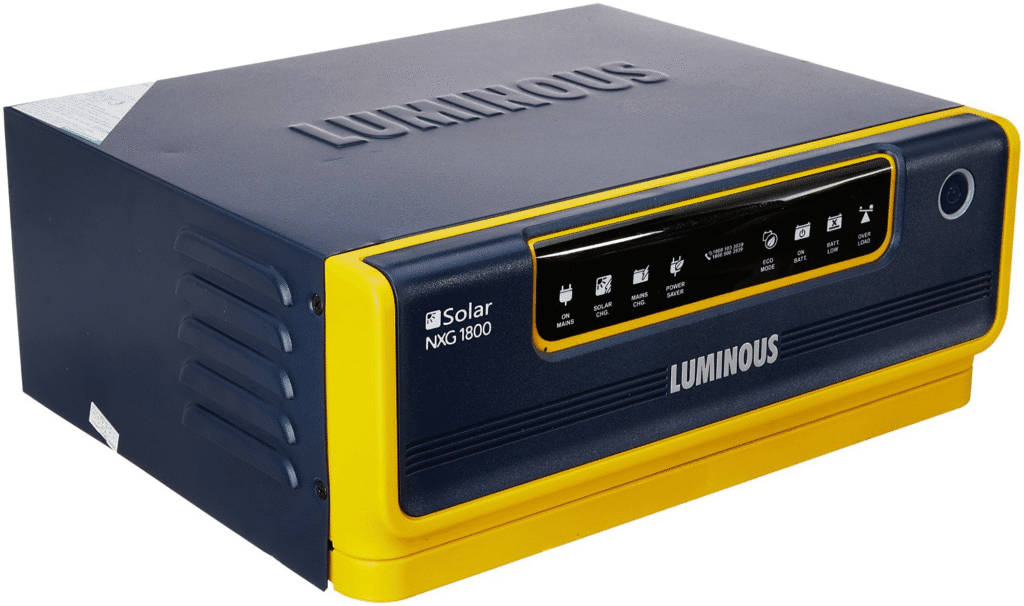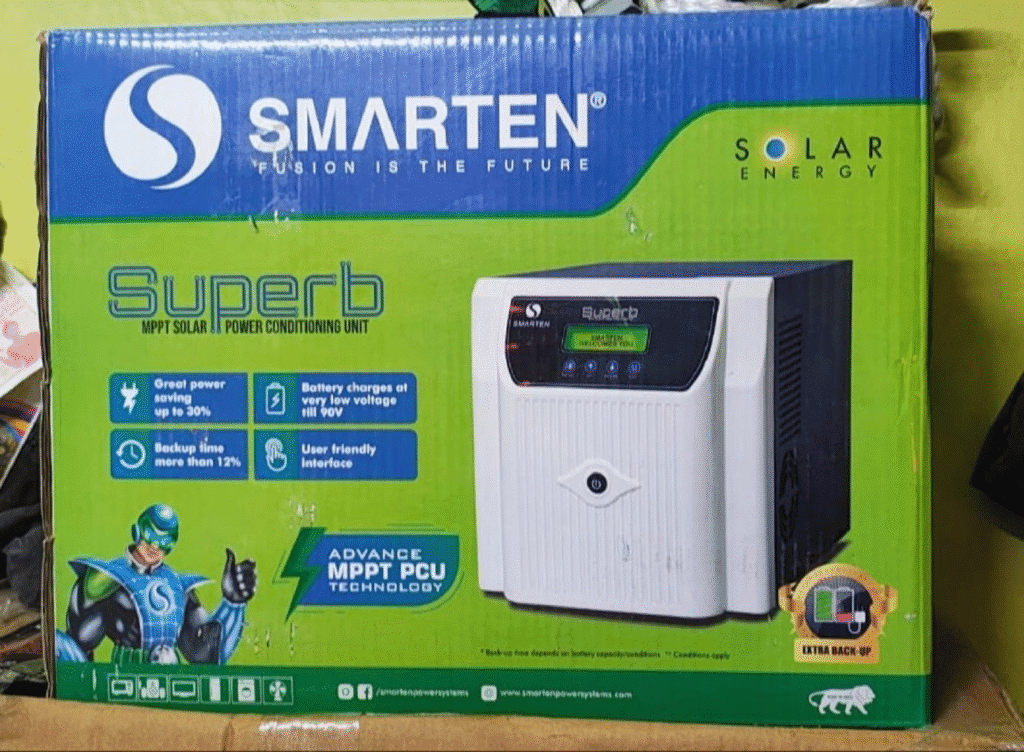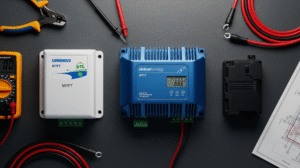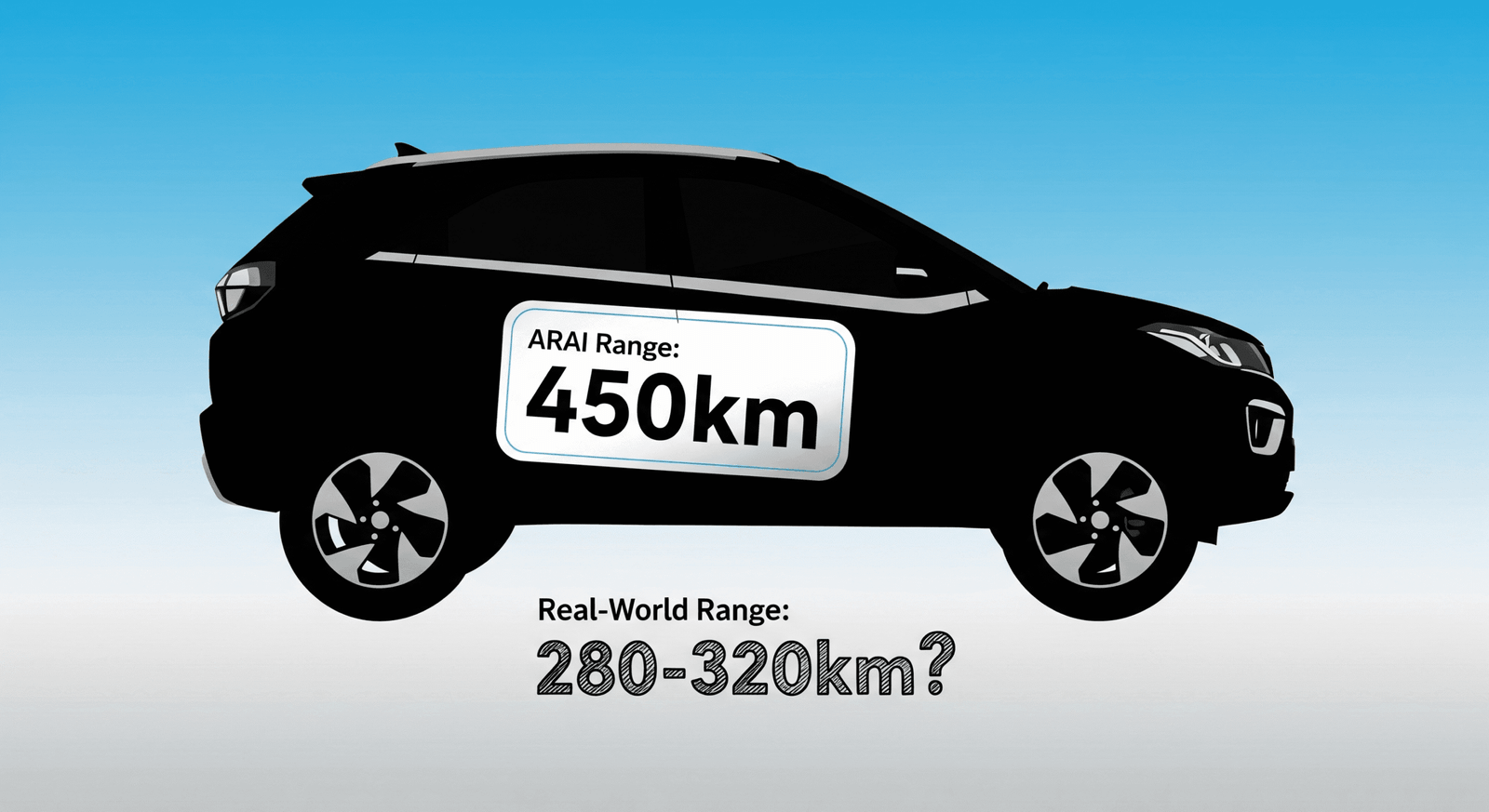Choosing a solar inverter for your home is the most important decision you’ll make in your solar journey. It’s the “brain” of your solar system, and the right choice can mean decades of reliable, free electricity. But with so many brands, types, and price points, the process can be overwhelming.
This is the only guide you need. We’ve analyzed the top brands, broken down the technology, and provided clear recommendations to help you find the perfect solar inverter for your home in India.
Inverter Efficiency Cost Calculator
Ever wonder how much “extra” you pay on your electricity bill to recharge the energy your inverter wastes? This tool calculates the hidden cost of DC-to-AC conversion.
Useful Energy for Appliance
Total Energy from Battery
Energy Wasted in Conversion
Cost to Recharge Useful Energy
“Phantom Cost” of Wasted Energy (Per Day)
What is the Price of a Solar Inverter in India?
Let’s start with the most important question. Solar inverter prices in India depend on three factors: type, capacity (in kW or kVA), and brand. Here is a general estimate of what you can expect to pay for the inverter alone in 2025.
| Capacity | On-Grid Inverter Price | Off-Grid Inverter Price | Hybrid Inverter Price |
| 1kW | ₹15,000 – ₹25,000 | ₹12,000 – ₹20,000 | ₹20,000 – ₹35,000 |
| 3kW | ₹30,000 – ₹45,000 | ₹25,000 – ₹40,000 | ₹40,000 – ₹60,000 |
| 5kW | ₹45,000 – ₹70,000 | ₹40,000 – ₹65,000 | ₹60,000 – ₹90,000 |
The 3 Types of Solar Inverters Explained
Before you choose a brand, you must choose a type. This is the most fundamental decision.

- On-Grid (Grid-Tie) Inverters: These are the simplest type. They connect directly to the grid and do not use batteries. They are perfect for homeowners whose primary goal is to reduce their electricity bill through net metering. They do not provide power during an outage.

- Off-Grid Inverters: These are designed for remote locations with no grid access. They use solar panels to charge a battery bank, and the inverter then pulls power from the batteries to run your home. They are for complete energy independence.
- Hybrid Inverters: This is the most popular and recommended choice for modern Indian homes. A hybrid inverter is the “best of both worlds.” It can connect to the grid to reduce your bills, but it can also charge a battery bank to provide backup power during an outage.
Which Brand of Solar Inverter is Best in India?
The Indian market is dominated by a mix of trusted local giants and high-quality international brands. Here’s an honest look at the top players.
- Luminous & UTL: These are the undisputed leaders in the Indian home solar market. They have a massive service network, are known for their robust and reliable products (especially hybrid inverters), and are trusted by millions. You cannot go wrong choosing one of these.
- Microtek, Smarten, & Havells: These brands offer fantastic value for money. They are strong competitors to Luminous and UTL, often providing similar features at a slightly more budget-friendly price point.
- Growatt & Solis: If you are installing a pure On-Grid system, these international brands are often considered the gold standard for efficiency and reliability.
Our Top Picks for the Best Solar Inverter for Home (2025)
After a deep analysis of technical datasheets, user manuals, and performance data, here are our definitive recommendations. We’ve gone beyond the marketing claims to give you an expert’s view on why these specific models deserve a place in your home.
🏆 Best Overall Solar Inverter in India: Luminous NXG+ Hybrid Inverter

The Luminous NXG+ series earns our top spot because it represents the perfect balance of performance, reliability, and unparalleled service support in the Indian context. It’s the ultimate “peace-of-mind” choice for the average homeowner.
- Why it’s our top pick: This is a true hybrid workhorse. It intelligently prioritizes solar energy, saving you money on your electricity bills, and seamlessly switches to battery power within milliseconds of a grid outage. Its robust build is designed to handle the demanding Indian power conditions, from voltage fluctuations to high temperatures.
- Best For: Homeowners who want a reliable, set-and-forget system that reduces monthly bills and provides essential backup power without needing constant tweaking.
- Technical Deep Dive: According to its engineering manual, the NXG+ series uses a Pure Sine Wave output with a Total Harmonic Distortion (THD) of less than 3%. This is critical for the safety of sensitive appliances like modern refrigerators and computers. The datasheet also specifies its compatibility with a wide range of battery types, including Tall Tubular and Lithium-ion, giving you flexibility for future upgrades.
- Suhas’s Take: “I consistently recommend Luminous to family and friends for one simple reason: trust. While other inverters might have slightly higher specs on paper, Luminous’s real-world reliability and the fact that you can find a qualified service technician in nearly any town in India is an unbeatable long-term value proposition.”
💡 Best Hybrid Inverter for Power Backup: UTL Gamma Plus

If your primary concern is navigating long and frequent power cuts, the UTL Gamma Plus is in a class of its own. Its primary design focus is to maximize battery charging and health, ensuring you have the most power possible when the grid goes down.
- Why it’s our top pick: The Gamma Plus features UTL’s proprietary “rMPPT” (Rapid Maximum Power Point Tracking) charge controller. In our analysis, this technology consistently extracts more power from solar panels, especially during cloudy conditions or in the early morning and late evening, compared to standard MPPT controllers.
- Best For: Homes in areas with unreliable grid power, or for users who want to maximize their energy independence and battery performance above all else.
- Technical Deep Dive: The official performance datasheet for the Gamma Plus shows its rMPPT algorithm can sweep the panel’s voltage range significantly faster than competitors. It also features a multi-stage battery charging profile (Bulk, Absorption, Float) that, according to the user guide, is specifically designed to improve the lifespan of lead-acid batteries by preventing overcharging and deep discharging.
- Suhas’s Take: “The Gamma Plus is the inverter I’d choose for a serious off-grid or heavy backup setup. It’s built like a tank, and the rMPPT technology isn’t just marketing hype—it genuinely squeezes every last drop of energy from your panels into your batteries. It’s the choice for the user who hates wasting a single watt of sunlight.”
💰 Best Budget-Friendly Inverter: Smarten Superb

For those looking for maximum value without compromising on essential features, the Smarten Superb series is the clear winner. It brings premium technology, like an MPPT charge controller, to a much more accessible price point.
- Why it’s our top pick: Smarten has focused on delivering core performance where it counts. While it may lack some of the bells and whistles of more expensive models, it has a highly efficient MPPT charge controller, a reliable inverter, and a user-friendly display. It’s a no-nonsense performance machine.
- Best For: Budget-conscious buyers who are starting their solar journey and want the best possible performance without paying for features they don’t need.
- Technical Deep Dive: The user manual for the Superb 2500 model highlights its high overload capacity, allowing it to handle surges from appliances like water pumps without tripping. The internal specifications also show a focus on durability, with a robust transformer that can handle a wide input voltage range, a critical feature for grid stability in many parts of India.
- Suhas’s Take: “The Smarten Superb is the ‘smart money’ choice. It’s proof that you don’t need to spend a fortune to get a high-efficiency MPPT inverter. For most 2-3 battery setups, it delivers 90% of the performance of the top-end models for a fraction of the cost. It’s the best value on the market, period.”
☀️ Best On-Grid (Grid-Tie) Inverter: Growatt MIN Series

If you have a reliable grid connection and your only goal is to reduce your electricity bill to zero through net metering, a dedicated on-grid inverter is the most efficient solution. In this category, Growatt is a global leader.
Suhas’s Take: “For a pure grid-tie system, you don’t want or need the complexity of a hybrid. You want an efficiency powerhouse, and that’s the Growatt MIN. It’s small, silent, incredibly effective, and comes with a great monitoring app. If you’re not planning for battery backup, this is the specialist tool for the job.”
Why it’s our top pick: The Growatt MIN series is renowned for its incredible efficiency, reliability, and compact design. It’s a pure power-conversion machine, designed to convert the maximum amount of DC solar energy into AC grid power with minimal loss.
Best For: Urban homeowners with stable grid connections who want to maximize their financial returns from a solar installation via net metering.
Technical Deep Dive: The compliance datasheet specifies a peak efficiency of up to 98.4%, making it one of the most efficient residential inverters available. The user manual also details its fanless heat sink design, which means it runs silently and has fewer moving parts that can fail, contributing to its long-term reliability.
Frequently Asked Questions About Solar Inverters
A solar inverter is the brain of a solar power system. Its main function is to convert the Direct Current (DC) electricity that solar panels generate into Alternating Current (AC) electricity. AC is the standard form of power used by all appliances in your home, from your lights and fans to your TV and refrigerator. Without an inverter, the power from your solar panels would be unusable for your home.
For most Indian homes, a **Hybrid Inverter** is the best choice. This type of inverter works with the electricity grid to reduce your bills but also charges a battery bank to provide essential backup power during the frequent power cuts experienced in many areas.
Leading brands like **Luminous, UTL, and Microtek** are considered top choices in India due to their robust build quality, reliability, and wide service networks.
A normal inverter only has one job: to draw power from a battery and convert it to AC power for your home when the main grid fails. It cannot manage power from solar panels.
A **solar inverter** is much more advanced. It contains a built-in solar charge controller (like an MPPT) that allows it to intelligently manage power from three sources: the solar panels, the batteries, and the grid. It can use solar power to run your home, charge your batteries, and even send surplus power back to the grid, which a normal inverter cannot do.
The three main types of solar inverters are:
- On-Grid (or Grid-Tie): These inverters are connected to the public electricity grid. They reduce your electricity bill by feeding surplus solar power to the grid, but they do not have batteries and will shut down during a power cut for safety reasons.
- Off-Grid: These inverters are for remote locations without grid access. They use solar panels to charge a large battery bank, and the home runs entirely on the stored battery power. They are completely independent of the grid.
- Hybrid: The most popular choice for modern homes, hybrid inverters are the “best of both worlds.” They are connected to the grid to save you money but can also charge a battery bank to provide backup power during an outage.
MPPT stands for **Maximum Power Point Tracking**. It is an advanced, highly efficient technology within a solar inverter’s charge controller. Its function is to continuously adjust the inverter’s electrical operating point to find the perfect voltage and current combination that will extract the maximum possible amount of power from your solar panels at any given moment. An inverter with MPPT technology can harvest up to 30% more energy than older technologies, especially in variable weather conditions like cloudy days.
Yes, in most cases, you can use a normal inverter battery (like a lead-acid tubular battery) with a solar inverter. However, batteries specifically designed for solar (often called C10 batteries) are built to withstand the deep and frequent charge/discharge cycles that are common in a solar power system. While your existing battery will work, a dedicated solar battery may offer a longer operational lifespan in a solar setup.
Connecting your inverter to WiFi lets you monitor your system’s performance. The general process is:
- Check for a WiFi Dongle: Your inverter needs a small WiFi device, which either comes with it or can be purchased separately. This plugs into a specific port on the inverter.
- Download the Brand’s App: Go to the Google Play Store or Apple App Store and download the official mobile app for your inverter brand (e.g., Luminous has the “ConnectX” app, Growatt has “ShinePhone”).
- Follow In-App Instructions: The app will guide you through connecting your phone to the dongle’s temporary WiFi network, and then connecting the dongle to your home’s main WiFi router.

Suhas Shrikant is the founder of Vecharged and an engineering enthusiast specializing in high-power off-grid solar systems. He has designed and built over a dozen custom systems and uses his hands-on, field-tested experience to create Vecharged’s expert guides and reviews.














